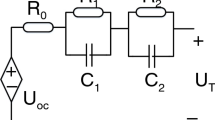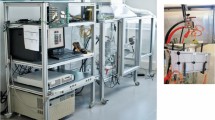Research on heat generation for a Lithium-ion battery during the discharging process is of great practical importance. Mainly because the heat generation whilst discharging directly affects the safety, performance, and lifetime of the battery. This study proposes a method to analyze the heat generation in a battery model with regards to a series of physical and electrochemical parameters. A group of mathematical equations are developed to describe the electrochemical behavior. These equations are solved using finite element analysis. The report also studies the relationship of the generated heat of the battery with parameters such as the active material particle size, electrode surface density, and reaction coefficient. By optimizing the negative electrode particle size, the value of maximum temperature rising could be reduced by 10°C. The irreversible heat accounts for a large proportion of the total generated heat. By optimizing the electrode surface density, the maximum rise of temperature would be reduced by 21.6°C. The result shows that physicochemical parameters of the Lithium- ion battery have a significant effect on battery heat generation.








Similar content being viewed by others
References
J. Kim, J. Oh, H. Lee. Review on battery thermal management system for electric vehicles, Applied Thermal Engineering., 149, 192(2019).
A. Fotouhi, D.J. Auger, K. Propp. A review on electric vehicle battery modelling: From Lithium-ion toward Lithium-Sulphur, Renew. Sustain Energy Rev., 56, 1008(2016).
J. Newman, K.E. Thomas-Alyea. Electrochemical Systems, third ed. John Wiley & Sons, Inc, Hoboken, New Jersey, 2004.
X.M. Xu, G.Y. Gong, R.Z. Li, Numerical study and optimizing on cold plate splitter for lithium battery thermal management system. Applied Thermal Engineering., 167, 114787(2020).
X. Feng, M. Ouyang, X. Liu, L. Lu, Y. Xia, X. He. Thermal runaway mechanism of lithium ion battery for electric vehicles: a review, Energy Storage Mater., 10, 246(2018).
M. Malik, I. Dincer, M.A. Rosen, et al. Thermal and electrical performance evaluations of series connected Li-ion batteries in a pack with liquid cooling, Appl. Therm. Eng., 129. 472(2018).
M.H. Amini, O. Karabasoglu. Optimal Operation of Interdependent Power Systems and Electrified Transportation Networks, Energies., 11, 196(2018).
T. Yang, N. Yang, X. Zhang, G. Li. Investigation of the thermal performance of axial flow air cooling for the lithium-ion battery pack. Int. J. Therm. Sci., 108. 132(2016).
A.M. Sefidan, A. Sojoudi, S.C. Saha. Nanofluid-based cooling of cylindrical lithium ion battery packs employing forced air flow. Int. J. Therm. Sci., 177. 44(2017).
C.D. Guo, Z.X. Zuo, H.H. Feng, B.R. Jia. Review of recent advances of free-piston internal combustion engine linear generator. Applied Energy., 269. 115084(2020).
R. Xiong, L.L. Li, Q.Q Yu. A set membership theory based parameter and state of charge co-estimation method for allclimate batteries. Journal of Cleaner Production., 249. 119380(2020)..
Y. Liu, S. Tang, L.X. Li, M. Jia. Simulation and parameter identification based on electrochemical-thermal coupling model of power lithium ion-battery. Journal of Alloys and Compounds. 844. 156003(2020).
D.F. Wang, H.Q. Huang, Z.H. Tang. A lithium-ion battery electrochemical–thermal model for a wide temperature range applications. Electrochimica Acta., 362. 137118(2020).
A. Fatouhi, D.J. Fatouhi. A review on electric vehicle battery modelling: From Lithium-ion toward Lithium–Sulphur. Renewable and Sustainable Energy Reviews., 56. 1008(2016).
P. Peng, F. Jiang. Thermal safety of lithium-ion batteries with various cathode materials: A numerical study. International Journal of Heat and Mass Transfer., 103. 1008(2016).
M. Guo, G.H. Kim, R.E. White. A three-dimensional multi-physics model for a Li-ion battery. Journal of Power Sources., 240. 80(2013).
N. Baba, H. Yoshida. Numerical simulation of thermal behavior of lithium-ion secondary batteries using the enhanced single particle model. Journal of Power Sources., 252. 214(2014).
A.P. Schmidt, M. Bitzer, R.W. Imre, et al. Experiment-driven electrochemical modeling and systematic parameterization for a lithium-ion battery cell. J. Power Sources., 195. 5071(2010).
J. Marcicki, M. Canova, A.T. Conlisk, et al. Design and parametrization analysis of a reduced-order electrochemical model of graphite/LiFePO4 cells for SOC/SOH estimation. J. Power Sources., 237. 310(2013).
C. Zhu, F. Lu, C.C. Mi. Robust Predictive Battery Thermal Management Strategy for Connected and Automated Hybrid Electric Vehicles Based on Thermoelectric Parameter Uncertainty. IEEE J EM SEL TOP P., 6. 1796(2018).
M.H. Hu, Y.X. Li, S.X. Li. Lithium-ion battery modeling and parameter identification based on fractional theory. Energy., 165. 153(2018).
C. Edouard, J. Bernard. Parameter sensitivity analysis of a simplified electrochemical and thermal model for Li-ion batteries aging. Journal of Power Sources., 325. 482(2016).
L. Zhang, C. Lyu, G. Hinds, M. Ma. Parameter Sensitivity Analysis of Cylindrical LiFePO4 Battery Performance Using Multi-Physics Modeling. J. Electrochem. Soc., 161. A762(2014).
L. Zhang, C. Lyu, K. Ma. Thermal-Electrochemical Modeling and Parameter Sensitivity Analysis of Lithium-ion Battery. Chem. Eng. Trans., 33, 943(2013).
K. Jaewan, L. Hoseong. Review on battery thermal management system for electric vehicles. Applied Thermal Engineering., 149. 192(2019).
W. Huo, H. He, F. Sun. Electrochemical-thermal modeling for a ternary lithium ion battery during discharging and driving cycle testing, RSC Advances., 5. 57599(2015).
R. Zhao, J. Gu, J. Liu. An investigation on the significance of reversible heat to the thermal behavior of lithium ion battery through simulations. Journal of Power Sources. 266. 422(2014).
S. Du, Y. Lai, M. Jia. An investigation of irreversible heat generation in lithium ion batteries based on a thermoelectrochemical coupling method. Applied Thermal Engineering., 121. 501(2017).
R. Zhao, S. Zhang, J. Liu. A review of thermal performance improving methods of lithium ion battery: Electrode modification and thermal management system, Journal of Power Sources., 299. 557(2015).
Acknowledgements
This work is supported by Guangdong Province Science and Technology Innovation strategy special fund (pdjhb0659).
Author information
Authors and Affiliations
Corresponding author
Additional information
Translated from Khimiya i Tekhnologiya Topliv i Masel, No. 3, pp. 118–124 May – June, 2023.
Rights and permissions
Springer Nature or its licensor (e.g. a society or other partner) holds exclusive rights to this article under a publishing agreement with the author(s) or other rightsholder(s); author self-archiving of the accepted manuscript version of this article is solely governed by the terms of such publishing agreement and applicable law.
About this article
Cite this article
Yang, J. Simulation of the Process of Discharging a Lithium-Ion Battery in Relation to the Sensitivity of Its Parameters. Chem Technol Fuels Oils 59, 577–587 (2023). https://doi.org/10.1007/s10553-023-01558-w
Published:
Issue Date:
DOI: https://doi.org/10.1007/s10553-023-01558-w




